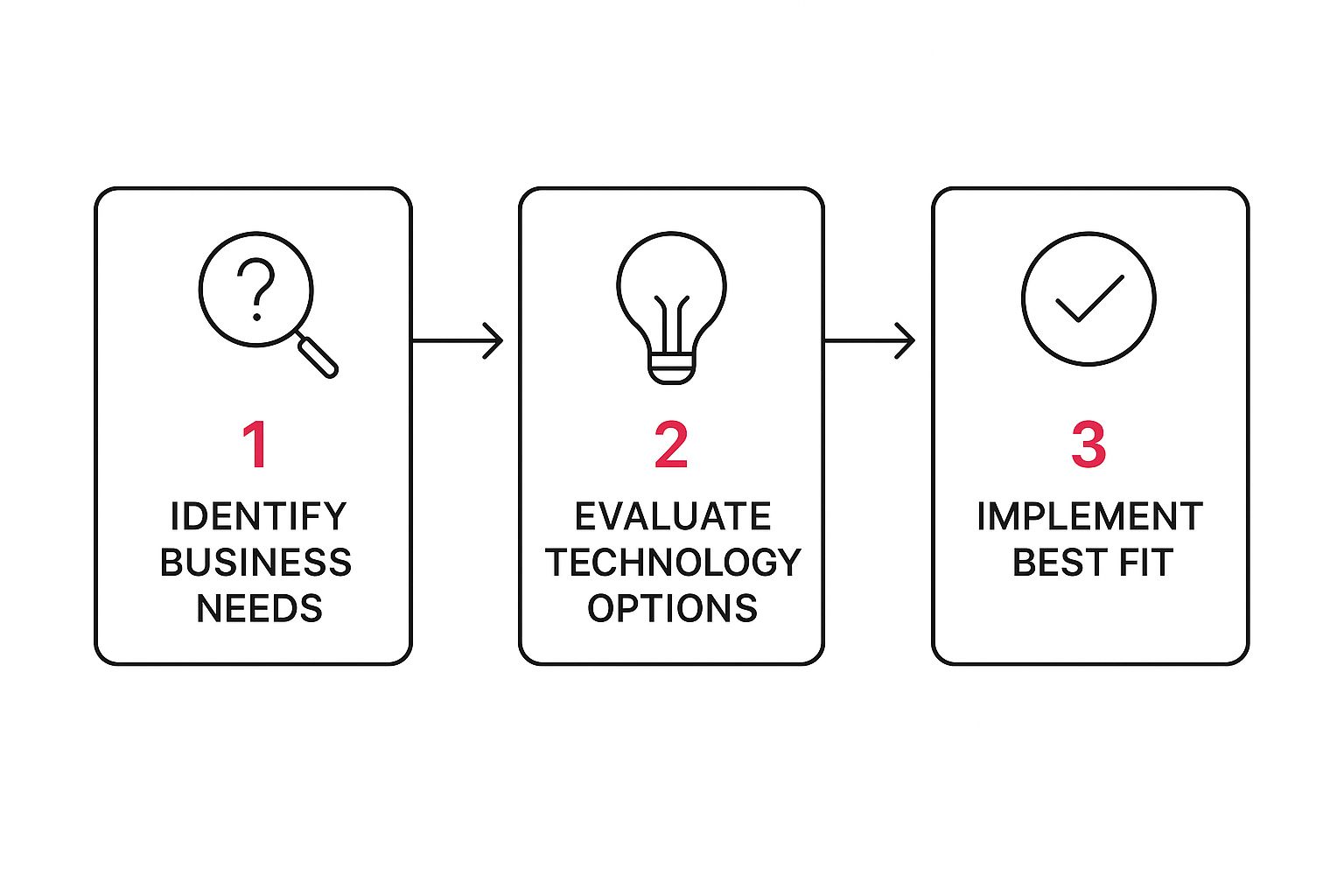A digital transformation strategy is much more than just a plan to buy new software. Think of it as your company's master plan for a complete overhaul—rethinking everything from daily operations and company culture to how you connect with your customers in a digital-first world.
What Is a Digital Transformation Strategy?

Imagine trying to build a complex puzzle without the picture on the box. You might connect a few pieces by chance, but you'll never see the final image. A digital transformation strategy is that picture on the box. It’s the critical link that ensures every technology investment, whether it's moving to the cloud or experimenting with AI, directly supports your most important business goals.
Without a clear strategy, you’re just buying expensive tools. With one, every new piece of tech has a clear purpose, guiding your organization's evolution with intention.
“Instead of launching it like a great big bang and running the risk of a huge failure, you take it more step by step. So it’s building up digital capability, but in a very step-by-step kind of way. And that allows the organization to much more readily absorb the change.”
This step-by-step thinking is what separates successful strategies from failed ones. It’s about building momentum through small, manageable wins instead of attempting a massive, risky overhaul all at once. This approach helps prioritize what matters, directs resources where they’ll have the most impact, and makes the change feel achievable for everyone involved.
The Heart of a Modern Strategy
At its core, a real digital transformation strategy isn't about simply digitizing your old paper-based systems. That’s just putting a digital wrapper on an outdated process. The real goal is to fundamentally reimagine how work gets done and how you create value for customers by asking, "How can technology help us do this in a completely new and better way?"
This shift is more than a trend; it's a powerful economic engine. Just look at the digital transformation market in the Middle East and North Africa (MENA) region. It has exploded from $1.12 billion in 2015 and is on track to hit $2.79 billion by 2025. This massive investment shows a deep commitment from businesses and governments to get ready for the future. You can discover more about how digital technology is growing the MENA economy to see these trends in action.
To get this right, a well-rounded strategy needs to stand on four key pillars. Each one addresses a different, but equally important, part of the business.
The Four Pillars of Digital Transformation
| Pillar | Core Objective | Real-World Example |
|---|---|---|
| Operational Optimization | Make internal processes faster, smarter, and more cost-effective. | A manufacturing company using IoT sensors on its assembly line to predict maintenance needs, preventing costly downtime. |
| Customer Experience | Create seamless, personalized, and memorable interactions for every customer. | A retailer using customer data to offer personalized product recommendations and a unified shopping experience online and in-store. |
| Business Model Innovation | Discover entirely new ways to make money and deliver value. | A traditional software company shifting from selling one-time licenses to a subscription-based (SaaS) model, creating recurring revenue. |
| Employee & Culture Enablement | Build a workforce that is agile, collaborative, and eager to learn. | An organization providing ongoing digital skills training and collaboration tools like Slack to break down departmental silos. |
By focusing on these four areas, you ensure that your transformation is comprehensive, touching every part of the organization.
Ultimately, a digital transformation strategy isn't a project with a start and end date. It's a continuous journey of evolution. It’s what prepares your organization to not just survive whatever comes next, but to lead the way.
Why Digital Transformation Is Now Essential
In today's fast-moving market, if you're standing still, you're actually falling behind. Having a solid digital transformation strategy isn't just for the big players anymore; it's a basic necessity for any business that wants to stick around and grow. Companies dragging their feet aren't just losing ground—they're risking becoming obsolete as their competitors use technology to work faster, connect with customers on a deeper level, and make sharper decisions.
Here’s a simple way to think about it. Imagine two shops on the same street. One is still using a paper ledger and a basic cash register. The other one installs a modern inventory system that tracks sales live, uses customer data to push out personalized discounts, and even automates reordering stock. That second shop isn't just updating its tools; it's building a powerful competitive edge that the first one will find nearly impossible to catch up with.
This isn't just theory. We consistently see that digitally mature companies run circles around their peers. They're more agile, more resilient, and far more focused on their customers. For them, technology isn't just another line item on the budget—it's the single most critical investment they can make in their future.
The Real-World Advantages
The payoff from a well-planned digital transformation goes way beyond just being a little more efficient. It fundamentally changes how your business operates and creates value. The most significant wins usually fall into three key areas:
- Lightning-Fast Operational Efficiency: When you automate repetitive tasks and streamline your digital workflows, you cut out wasted time, reduce human error, and let your team focus on work that actually drives the business forward. This means getting products to market faster, delivering better service, and slashing operational costs.
- Deeply Personalised Customer Experiences: By gathering and analyzing customer data, you can finally move away from the one-size-fits-all model. Instead, you can create tailored experiences that make customers feel seen and valued. This is how you build real loyalty, increase customer lifetime value, and turn happy clients into your biggest fans.
- Data-Driven Decision Making: Gut feelings have their place, but they can't run a business anymore. Digital tools give you access to real-time data and predictive analytics, so leaders can make confident, informed decisions. You can spot market shifts as they happen and make your move before your competitors even know what’s going on.
This proactive, data-first mindset is what truly separates the leaders from the followers. It’s the difference between reacting to change and being the one who drives it.
An Investment, Not an Expense
One of the biggest mistakes a business can make is seeing digital transformation as a cost. It's not. It's a direct investment in your company's resilience and its relevance for years to come. The proof is in the spending—businesses are pouring money into digital adoption because they know it’s essential for long-term stability.
For example, spending on digital transformation projects across the Middle East, Turkey, and Africa is expected to blow past $74 billion by 2026. That number will make up over 43% of all ICT investments in the region. This isn't just a trend; it's a clear signal that modern businesses see digital capability as non-negotiable for staying in the game. You can read more about these regional investment trends to get a sense of the scale of this movement.
A strong digital transformation strategy is the engine that drives a business from its current state to its future potential. It aligns technology, people, and processes toward a single, unified goal of delivering exceptional value in a digital world.
For smaller businesses, this whole process can feel daunting, but the core ideas are the same. Starting small with a few high-impact digital tools can completely level the playing field, helping you compete with much larger companies. If you're looking for where to begin, our guide on digital marketing for small businesses is a fantastic resource for using digital tools to fuel your growth.
At the end of the day, embracing digital transformation is about future-proofing your business and discovering new ways to succeed.
The Four Pillars of a Winning Strategy
A truly successful digital transformation strategy doesn't just happen. It’s built on four essential pillars that work together: Technology, People, Processes, and a relentless Customer Focus.

Think of it like building a table. If one leg is wobbly or missing entirely, the whole thing comes crashing down. It doesn't matter how great your tech is if your team won't use it. And the most brilliant, engaged team will get bogged down by clunky, outdated processes. Even if you get all that right, you’ll fail if you're not laser-focused on what your customers actually want.
Each pillar is critical. Let's break down how they fit together to create a strategy that actually works.
Pillar 1: Technology and Architecture
Technology is often the most talked-about part of digital transformation, but it’s not about chasing shiny objects. A smart strategy is about picking the right tools—like AI or cloud computing—that solve real business problems. The technology is the engine, but you have to choose the right one for the vehicle you're building.
For instance, a retailer might bring in an AI-powered inventory system. The goal isn't just to "use AI," but to solve a painful, costly problem: predicting stockouts before they happen. That direct line between the tech and a business outcome is what separates a winning strategy from a wasteful one.
But even the best engine needs a solid chassis. Your digital architecture is that foundation. As experts often say, the "plumbing" of your IT systems is the architecture of the business itself. If data is stuck in silos or your infrastructure can't scale, even the most advanced tools will sputter and fail. This means building on:
- Cloud-based platforms for the flexibility and scale you need to grow.
- Interconnected systems that let data flow freely and securely, breaking down departmental barriers.
- Scalable AI models that can handle more data and complexity as your business evolves.
Pillar 2: People and Culture
You can have the best tech in the world, but it's your people who have to make it work. This makes culture the most crucial—and often the toughest—pillar to get right. Real transformation demands a cultural shift, moving away from a rigid "this is how we've always done it" mindset to one of curiosity and continuous learning.
Look at Microsoft's own journey under CEO Satya Nadella. He didn't just talk about the cloud; he championed a "growth mindset." He actively encouraged people to experiment, learn from their mistakes, and collaborate. That cultural overhaul was the key that unlocked the company's ability to truly lead in cloud computing and AI.
Fostering a culture that supports digital adoption has to start at the top. Leaders must do more than sign checks for new software; they need to champion a mindset of continuous learning, psychological safety, and collaboration across the entire organization.
This involves creating an environment where trying something new and "failing fast" is seen as a learning opportunity, not a career risk. Innovation flourishes in these conditions. It also means committing to upskilling and reskilling your workforce so they feel confident and capable with the new digital tools at their disposal.
Pillar 3: Processes and Workflows
Bolting powerful new technology onto broken, outdated processes is like putting a Formula 1 engine in a horse-drawn buggy. You're not going to get the speed you're looking for. The third pillar is all about redesigning your internal workflows to be fast, agile, and efficient.
This goes way beyond just digitizing a few paper forms. It's about completely rethinking how work gets done. Instead of a manual approval process that snakes through multiple departments over several weeks, imagine an automated workflow that routes requests, gathers digital sign-offs, and gives everyone real-time updates—all in a matter of minutes.
The goal here is to remove friction and empower your teams. Key steps usually involve:
- Mapping out your current processes to find the real bottlenecks and time-wasters.
- Automating repetitive, low-value tasks to free up your people for more creative, strategic work.
- Adopting agile methods so teams can pivot quickly and respond to change without getting stuck in red tape.
By optimizing your processes, you build the strong operational backbone needed to support your bigger transformation goals.
Pillar 4: Customer Focus
Finally, and most importantly, every single part of your digital transformation strategy must revolve around your customer. The ultimate purpose of new tech, an empowered team, and streamlined processes is to deliver better experiences and more value to the people who buy from you.
This means using data to understand your customers more deeply than ever before. A classic example is Netflix. It uses sophisticated AI not just for fun, but to analyze viewing habits, ratings, and even what people search for. This data allows them to serve up hyper-personalized recommendations and make smarter bets on which shows to produce next. The result? A better customer experience that keeps people subscribed.
A customer-centric approach uses technology to solve real problems for your audience, creating seamless, personalized journeys that build loyalty for the long haul. When all four of these pillars are strong and working in harmony, your strategy becomes a powerful engine for real, sustained growth.
How to Build Your Digital Transformation Roadmap
A brilliant digital transformation strategy is just an idea until you give it legs. That’s what a roadmap does—it’s the practical, step-by-step guide that turns your big-picture vision into a series of concrete, achievable actions. Without one, even the best-laid plans can quickly become disorganized, lose momentum, and ultimately fail to deliver.
Think of it like planning a cross-country road trip. You wouldn't just point your car west and hope for the best, right? You'd map out your route, decide on key stops, book places to stay, and plan for fuel. A digital transformation roadmap provides that same clarity, ensuring every single initiative is deliberate and moves you closer to your final destination. It breaks a massive undertaking into manageable phases, helping you build momentum with early wins and keep everyone on the same page.
Phase 1: Discovery and Vision Setting
First things first: you need to know where you are before you can figure out where you're going. This initial phase is all about taking a good, hard look at your current situation. You can't chart a course to a new destination without knowing your starting point.
This means doing a deep dive into your existing capabilities. What are your operational strengths? What about your weaknesses? Where are the most painful bottlenecks in your current processes? Which legacy systems are holding you back? A huge part of this is actually talking to people—your employees and your customers—to understand their frustrations and what they truly need.
Once you have a clear picture of the present, you can start painting a picture of the future. This isn't just a shopping list of new technologies. It's about creating a compelling vision for what your business will look like after a successful transformation. For instance, your vision might be "to create a frictionless, personalized customer experience that increases retention by 25%" or "to automate 50% of manual back-office tasks to free up our team for more strategic work."
Phase 2: Strategic Planning and Prioritization
With a clear vision in hand, it's time to get tactical. This is where you translate those broad goals into specific, high-impact projects and, crucially, get the leadership buy-in you need to make them happen. You can't do everything at once, so you have to be smart about prioritizing.
You'll need to weigh potential projects based on two things: their potential business impact and how feasible they are to pull off. A project that promises a massive return but requires a complete overhaul of your entire infrastructure is probably too risky to tackle first. Instead, look for initiatives that offer a healthy balance of value and achievability.
The goal is to identify early wins—projects that can be delivered relatively quickly and will demonstrate tangible value. This builds momentum and helps convince skeptics that the transformation is not just a cost center but a real driver of growth.
Securing strong executive sponsorship is absolutely non-negotiable here. Leaders can't just sign off on the budget; they need to become active champions for the roadmap, communicating its importance and aligning the entire organization behind the effort.
This next graphic breaks down the simple logic for choosing technology, a key part of the planning process.

This straightforward flow—identify the need first, then evaluate the tech—makes sure every tool you adopt is tied directly to solving a real business problem. It’s the best way to prevent wasteful spending on shiny solutions that don’t actually fit.
To help structure your thinking, a phased roadmap is essential. Here is a simple table outlining the core stages of a typical transformation journey.
Your Digital Transformation Roadmap Phases
| Phase | Key Objective | Primary Activities |
|---|---|---|
| 1. Discovery & Vision | Understand the current state and define the future ambition. | Conduct internal audits, gather customer feedback, map processes, define a clear vision and key outcomes. |
| 2. Strategic Planning | Translate the vision into a prioritized action plan. | Identify key initiatives, assess impact vs. feasibility, secure executive sponsorship, and build the business case. |
| 3. Agile Implementation | Execute initiatives in manageable, iterative stages. | Launch pilot projects, gather feedback, manage change through communication and training, and deploy solutions incrementally. |
| 4. Continuous Improvement | Measure results and refine the strategy over time. | Track KPIs, analyze performance data, identify new opportunities, and adapt the roadmap as the business evolves. |
This framework provides a clear, logical progression, ensuring that each phase builds upon the last and moves your organization forward in a structured way.
Phase 3: Agile Implementation and Change Management
Now it's time to start building. The best way to implement today is with an agile approach—launching small-scale pilot projects to test ideas, learn fast, and adapt on the fly. This method dramatically reduces the risk compared to a "big bang" launch where everything goes live at once.
For example, instead of rolling out a new CRM system to the entire company, you could pilot it with a single sales team. This lets you gather real-world feedback, fix bugs, and fine-tune your training process before a full-scale deployment. This iterative cycle makes sure the final solution is truly fit for purpose.
Just as important as the tech is managing the human side of change. Your roadmap absolutely must include a solid change management plan that covers:
- Communication: Clearly and consistently explaining the "why" behind the changes.
- Training: Giving employees the skills and confidence they need to use new tools effectively.
- Support: Creating feedback channels and support systems to help people through the transition.
Phase 4: Continuous Improvement and Refinement
A digital transformation roadmap isn't a static document you create once and file away. It's a living, breathing plan that you must constantly monitor and adjust based on what you’re learning from the results. The final phase is all about establishing a cycle of measurement, learning, and adaptation.
You need to define Key Performance Indicators (KPIs) for each initiative before you launch. These could be operational metrics like process cycle time, customer metrics like satisfaction scores, or financial metrics like cost savings. Regularly tracking these KPIs will tell you what's working and what isn't.
Based on that data, you can make informed decisions about where to double down and where to pivot your strategy. This continuous improvement loop ensures that your digital transformation strategy stays relevant and keeps delivering value for the long haul. For more insights into creating plans that drive results, check out our guide on how to create a digital marketing strategy that converts.
Getting It Done: Key Practices for a Successful Rollout
A brilliant digital transformation strategy on paper is just that—paper. It doesn't mean a thing if it falls apart the moment you try to put it into practice. The bridge between your vision and real-world results is built with deliberate, proven practices. From my experience, the companies that truly succeed are the ones that treat implementation not as a final step, but as a discipline that demands focus, strong leadership, and a culture that's ready for change.
Without these foundational practices, even the most promising plans can quickly lose steam, run into resistance, and ultimately fail to deliver the value you were counting on. Let's walk through the actions that consistently separate successful transformations from expensive missteps.
Secure Unwavering Executive Sponsorship
I can't stress this enough: the single most critical factor for success is strong, visible, and active executive sponsorship. This is so much more than just getting a signature on the budget. Your leaders need to be the most passionate champions for the change, constantly explaining the 'why' behind the strategy and getting the entire company rowing in the same direction.
When leaders actively model the new behaviors—like actually using the new tools, encouraging teams to work together, and celebrating the small victories—they send a powerful message. This commitment from the top provides the authority needed to push past old habits and secure the resources to keep things moving.
Foster a Culture of Psychological Safety
Digital transformation is all about trying new things, and let's be honest, not every experiment is going to be a home run. A culture that punishes mistakes will kill innovation before it even starts. You have to build an environment of psychological safety, where your teams feel secure enough to take calculated risks, test out new ideas, and openly share what they learned from things that didn't pan out.
A culture that embraces digital adoption must start at the top. Leaders need to champion a mindset of continuous learning, psychological safety, and collaboration across the entire organization.
This idea is at the heart of the 'growth mindset' that companies like Microsoft have famously adopted. When you reframe failure as just a valuable piece of data, your teams become more resilient, creative, and much faster at solving problems. It’s this cultural shift that allows a digital transformation strategy to truly take root. For businesses in the UAE, getting organized is key; our free digital marketing strategy template can provide a solid framework for your plans: https://grassrootscreativeagency.com/free-digital-marketing-strategy-template-for-uae-success/
Prioritize People and Upskilling
Technology is just a tool. Your people are the ones who will wield it to create real value. A classic mistake I see all the time is companies pouring money into new systems while completely neglecting their workforce. A smart strategy must include a solid plan for upskilling and reskilling your employees.
This means figuring out what skills your business will need down the road and providing easy-to-access training to close those gaps. Investing in your people doesn't just ensure they can use the new digital tools effectively; it also boosts morale and shows them they are a crucial part of the company's future.
Break Down Data Silos
Data is the fuel for any digital initiative, but it’s completely useless if it’s locked away in different departments that don't talk to each other. You have to actively work to break down these data silos and create a single, clear picture of your business operations and customer interactions.
- Integrate Key Systems: Start by connecting your CRM, ERP, and marketing automation platforms. Let the data flow freely between them.
- Establish Data Governance: Create clear rules for how data is collected, stored, and used. This ensures your data is both high-quality and secure.
- Empower Teams with Access: Give your teams the tools and permissions they need to get their hands on the data that’s relevant to their jobs.
A huge part of a winning strategy is mastering your customer digital journey to build growth and stronger relationships, and you simply can't do that with fragmented data. When data is accessible and easy to understand, you empower everyone in the organization to make smarter, evidence-based decisions that push the whole business forward.
The Infrastructure Powering Transformation

A great digital transformation strategy is more than just clever ideas and slick software. It needs a rock-solid foundation to support it. Think of it like building a skyscraper—you can design the most beautiful building in the world, but it's nothing without the concrete and steel structure to hold it up.
In the digital world, that structure is your infrastructure. It's the physical hardware, the data centers, and the networks that make everything from cloud computing to AI-powered analytics actually work.
This link between vision and hardware is especially clear in the Middle East, where ambitious national goals are driving a massive boom in data center construction. We’re not talking about a few extra server rooms. These are hyperscale facilities—the digital backbone required to power smart cities, run cloud-native services, and fuel national AI initiatives.
The physical infrastructure is where a digital strategy stops being a concept and starts becoming a reality. It's the tangible "stuff" that turns ambitious goals for innovation and economic growth into something you can actually use.
Having this kind of infrastructure isn't just a technical detail; it's a powerful strategic asset. It attracts global investment, nurtures local innovation, and cements a region's place as a serious competitor on the world stage.
From Vision to Reality
The recent explosion in data center capacity across the Middle East isn't happening by accident. It's a direct response to strategic government commitments. Take Saudi Arabia, for instance, which expects AI to contribute 12.4% to its GDP by 2030. The UAE projects a 14% boost from similar programs.
Those numbers are only achievable because of the massive investment in the underlying "plumbing" of the digital economy. This wave of hyperscale data center construction creates an environment where businesses have the raw power and speed they need to bring their own transformation plans to life.
Optimizing the Digital Engine
Of course, just having a powerful infrastructure isn't enough. You have to make sure it runs efficiently. This is all about managing how your data is stored, accessed, and delivered to your users as quickly and reliably as possible.
One of the most practical things you can do is focus on performance. A huge part of this is understanding the different types of caching. By implementing smart caching strategies, you ensure your websites and applications feel fast and responsive, which is absolutely critical for a good customer experience.
It’s a perfect example of how a seemingly technical detail directly supports the big-picture goal of creating seamless digital journeys. The choices you make at the infrastructure level have a very real impact on your business's success.
Of course! Here is the rewritten section, designed to sound natural and human-written, following all your specific requirements.
Answering Your Top Questions About Digital Transformation
It’s only natural to have a lot of questions when you’re considering a shift as big as digital transformation. Leaders, and rightly so, want to get their arms around the potential risks, understand what success really looks like, and feel solid in their plan before diving in. Getting these common questions out in the open and answered clearly is a huge step toward getting everyone on the same page and ready for what’s ahead.
Let’s tackle some of the most pressing questions we hear from organizations as they start this journey.
How Do We Actually Measure the ROI?
Figuring out the return on investment (ROI) for a digital transformation isn't just about looking at the bottom line next quarter. A real measure of success is a blend of different key performance indicators (KPIs) that show you're making improvements across the entire business.
The trick is to first get a crystal-clear picture of where you're starting from—your baseline. Once you have that, you can track your progress against a few key areas:
- Operational Efficiency: Are you seeing cost savings from automating repetitive tasks? Have error rates dropped? Are you getting things done faster?
- Customer Experience: You can measure this through higher customer satisfaction scores (CSAT), better customer retention, and an increase in lifetime value.
- Employee Productivity: Look for metrics like time saved on administrative busywork or increased output now that your teams have better digital tools.
And, of course, a huge win is creating brand-new revenue streams that didn't exist before, like launching a subscription service or finding a way to monetize your data.
The single biggest challenge is almost always cultural resistance to change. Technology is the tool, but successfully guiding people through the transition is where most strategies either succeed or fail.
What Is the Biggest Challenge We'll Face?
While the technology itself can have its hiccups, the biggest and most common roadblock is almost always cultural resistance. Let's be honest—people get comfortable with their routines. The idea of changing everything can stir up a lot of anxiety and pushback.
Getting past this hurdle means you have to be deliberate about change management. Your strategy needs to be built on clear, constant communication that doesn't just explain what is changing, but why it’s happening. It also means investing in good training so people feel confident with new systems and, most importantly, bringing employees into the process. When people feel a sense of ownership, they get excited about the future instead of fearing it.
Should a Small Business Bother With This?
Absolutely. Digital transformation isn't just a game for giant corporations with deep pockets. For a small business, it's a fantastic way to become more nimble, punch above your weight, and just run a much tighter ship.
It doesn’t have to be some massive, bank-breaking overhaul either. For a small business, transformation can look like:
- Switching to cloud-based accounting software to automate invoicing.
- Using a simple CRM to keep track of customer conversations.
- Tapping into digital marketing tools to find customers you couldn't reach before.
The key is to start small. Find a real pain point, fix it with a targeted project, and build from there. You can scale up your efforts as your business and confidence grow.
Ready to build a digital transformation strategy that drives real results? At Grassroots Creative Agency, we specialize in creating data-supported plans that elevate your brand and accelerate your growth. Book a consultation with us today!








